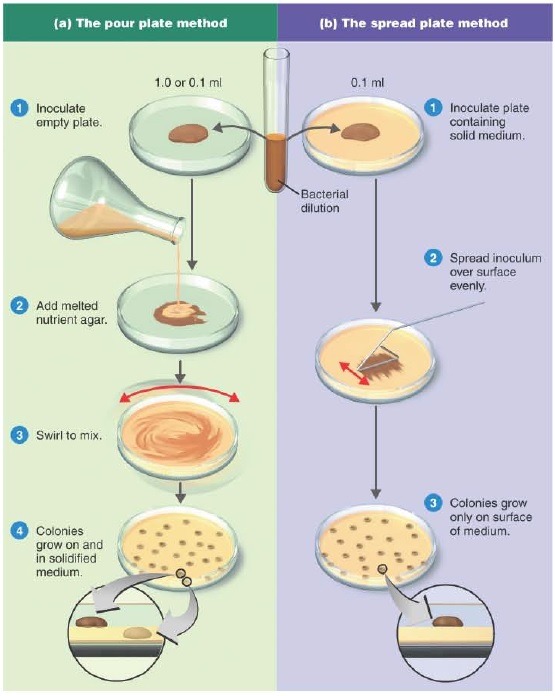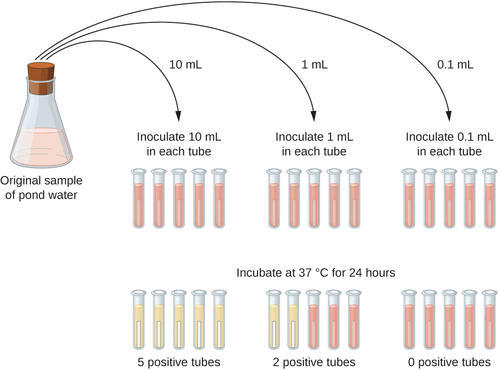Measurements of microbial growth
Introduction
- When a few bacteria are inoculated into a liquid growth medium or any solid culture media and the population is counted at intervals.
- The growth of microbial populations can be measured in a number of ways. Some methods measure cell numbers; other methods measure the population’s total mass, which is often directly proportional to cell numbers.
- It is orderly increase in a cellular constituent.
- When microorganisms reproduce by binary fission or budding then it also leads to increase in the number of cells.
Measurements of microbial growth
- There are various ways to measures microbial growth for the determination of growth rates and generation times.
- For the measurement of growth either mass or population number is followed because growth leads to increase in both.
- Growth can be measured by one of the following types of measurements:
-
- Cell count this method involves the measurement of growth either by microscopy or by using an electronic particle counter or indirectly by a colony count.
- Cell mass in this growth can be measured directly by weighing or by a measurement of nitrogen concentration in cells or indirectly by the determination of turbidity using spectrophotometer.
- Cell activity in this growth can be measured indirectly by analysis of the degree of biochemical activity to the size of population.
Some specific procedure will illustrate the application of each type of measurement
- Direct microscopic count
- Electronic enumeration of cell numbers
- The plate count method
- Turbidity estimation of bacterial numbers
- Determination of nitrogen content
- Determination of dry weight of cells
- Filtration method
- Most Probable Number (MPN) Method
Direct microscopic count
- The most obvious way to count microbial numbers is through direct counting.
- Petroff-hausser counting is one of the easiest and accurate way to count bacteria.
- Side view of the chamber showing the cover glass and the space beneath it that holds a bacterial suspension.
- A top view of the chamber. The grid is located in the center of the slide.
- An enlarged view of the grid. The bacteria in several of the central squares are counted, usually at X400 to X500 magnification.

- Concentration of the cells can be calculated by using the average no. of bacteria the avg. number of bacteria in these squares.
- There are 25 squares covering a part of area of 1 mm2, then the entire number of bacteria in 1 mm2 of the chamber is (number/square) (25 squares). The chamber is 0.02 mm deep and thus, bacteria/mm3 = (bacteria/square) (25 squares) (50).
- The amount of bacteria per cm3 is 103 times this value. For example, imagine the average count per square is 28 bacteria: bacteria/cm3 = (28 bacteria) (25 squares) (50) (103) = 3.5X 107.
Electronic enumeration of cell numbers
- In this method of microbial growth measurement, bacterial suspension is kept inside an electronic particle counter, within which the bacteria are passed through tiny orifice 10 to 30 μm in diameter.
- This orifice is then connected to the two compartments of the counter which contains an electrically conductive solution.
- The electrical resistance between two compartments will increases momentarily, when bacterium passes through the orifice. This generates an electrical signal which is automatically counted.
- The main disadvantage of this method is that there is no way to determine whether the cell counted is viable or not.
The plate count method

- This method allows the determination of the number of cells that will multiply under certain defined conditions.
- Plate count method can be done in two ways either by spread plate method or by pour plate method.
- This method of bacterial counting is most commonly used with satisfactory results for the estimation of bacterial populations in milk, water, foods and many other materials.
- This technique has some drawbacks because some relatively heat-sensitive microorganisms may be damaged by the melted agar and will therefore be unable to form colonies
Turbidity estimation of bacterial numbers

- For some experimental work, turbidity is a only practical way of monitoring bacterial growth.
- actical way of monitoring bacterial growth. As bacteria multiply in a liquid medium, the medium becomes turbid, or cloudy with cells.
- Turbidity is the Cloudiness or haziness of a media or fluid caused by large no. of individual particles.
- The instrument used to measure turbidity is a spectrophotometer (or colorimeter).
- Microbial mass can be determined by determination of absorption of light.
- In the spectrophotometer, a beam of light is transmitted through a bacterial suspension to a light-sensitive detector, as the bacterial numbers increase, less light will reach the detector.
- As the population increases, absorbance of the light increases by the cells, so the turbidity also increases. Turbidity can be measured by using an instrument spectrophotometer.
- The absorbance is used to plot bacterial growth.
Determination of nitrogen content
- The major constituents of cell material are protein, and since nitrogen is characteristics part of proteins.
- Bacterial population or cell crop can measure in terms of bacterial nitrogen.
- In this growth can be measured by first harvesting the cells and wash them free of medium and then perform a quantitative chemical analysis of nitrogen.
Determination of dry weight of cells
- For filamentous bacteria and molds, the usual measuring methods are less satisfactory. A plate count would not measure this
increase in filamentous mass. - In plate counts of actinomycetes and molds, it is mostly the number of asexual spores that is counted instead.
- This is not a good measure of growth. One of the better ways to measure the growth of filamentous organisms is by dry weight.
- In this procedure, the fungus is removed from the growth medium,
filtered to remove extraneous material, and dried in a desiccator, it is then weighed. - Growth measurement by measuring cell mass is one of the easiest ways, a known volume of culture sample from the ferment or withdrawn and centrifuged.
- It is the most direct approach for quantitative measurement of a mass of cells.
Counting bacteria by filtration method

- When the number of bacteria is extremely few, as in lakes or relatively pure streams, bacteria are often counted by filtration methods.
- During this technique, a minimum of 100 ml of water are passed through a thin membrane filter whose pores are too tiny to permit bacteria to pass.
- After filtration bacteria are filtered out and present on the surface of the filter. Then filter is transferred to a Petri plate containing a in liquid nutrient medium, where colonies grow from the bacteria on the filter’s surface.
- This method is applied frequently to detection and enumeration of coliform bacteria, which are indicators of fecal contamination of food or water.
Most Probable Number (MPN) Method

- Another method for determining the number of bacteria in a sample is the most probable number (MPN) method.
- This statistical estimating technique is based on the fact that the greater the number of bacteria in a sample, the more dilution is needed to reduce the density to the point at which no bacteria are left to grow in the tubes in a dilution series.
- The MPN method is most useful when the microbes being counted will not grow on solid media (such as the chemoautotrophic nitrifying bacteria).
- It is also useful when the growth of bacteria in a liquid differential medium is used to identify the microbes (such as coliform bacteria, which selectively ferment lactose to acid, in water testing).
- The MPN is only a statement that there is a 95% chance that the bacterial population falls within a certain range and that the MPN is statistically the most probable number.
Reference and sources
- https://www.slideshare.net/TanzirAhmed7/reproduction-and-growth-of-bacteria-by-tanzir
- https://sacmicro.files.wordpress.com/2016/02/bacterial-growth-and-measurement-2017.doc
- https://www.scribd.com/presentation/88673536/Lecture-10-MIC310
- https://quizlet.com/230936447/chapter-6-microbial-growth-flash-cards/
- https://www.biologydiscussion.com/microorganisms/measurement-of-cell-numbers-and-cell-mass-ofmicroorganisms/55160
- https://microbeonline.com/techniques-of-isolation-and-enumeration-of-bacteria/
- http://bs.kaist.ac.kr/~jhkim/Chapter_7(pdf).pdf
- https://fahad-hussain.blogspot.com/
- https://www.preservearticles.com/biology/what-are-the-methods-of-measuring-microbial-growth/28473
- http://ecoursesonline.iasri.res.in/mod/page/view.php?id=5146
- https://www.slideshare.net/SaajidaSultaana/different-phases-of-growth-growth-curve
Measurements of microbial growth
Also Read
- Plasmid: Properties, Types, Replication and Organization
- Types of microscopes
- Water as a Microbial Habitat
- Amino acids: physical, chemical properties and peptide bond
- Vector: properties, types and characteristics
- Overview of lac operon an inducible operon
- Deoxyribonucleic acid (DNA)
- DNA replication in prokaryotes
- Techniques for Identifying Mutants
- Citric acid: Introduction, Fermentation, Recovery and Uses
- Viruses Arise from Genetic Recombination and Mutation
- Omicron: Overview, Transmissible, Vaccination and Severity of disease

Best content ❤️👍🏻